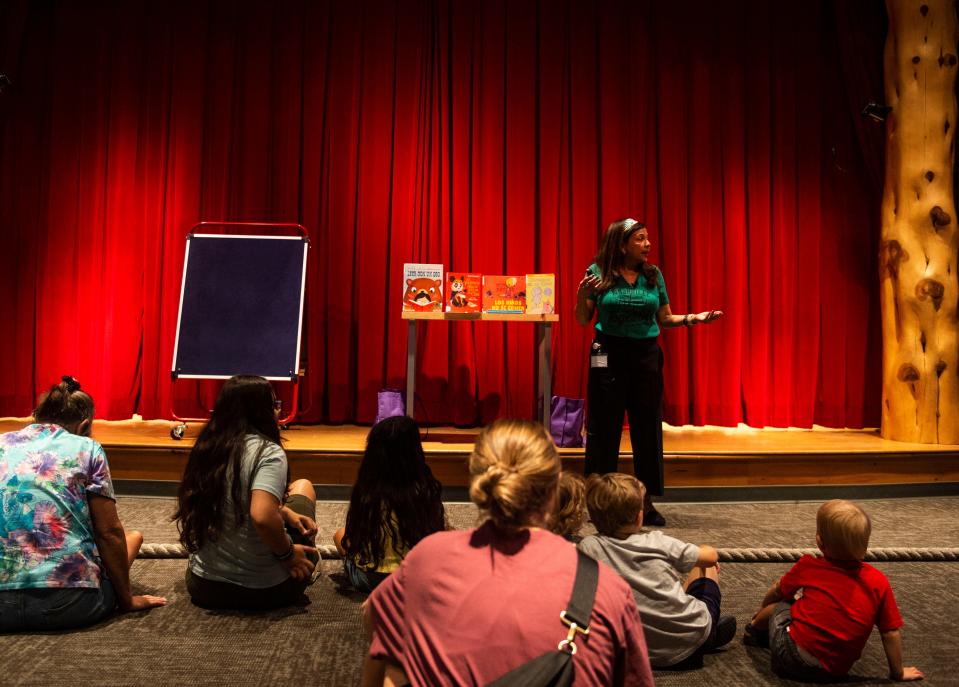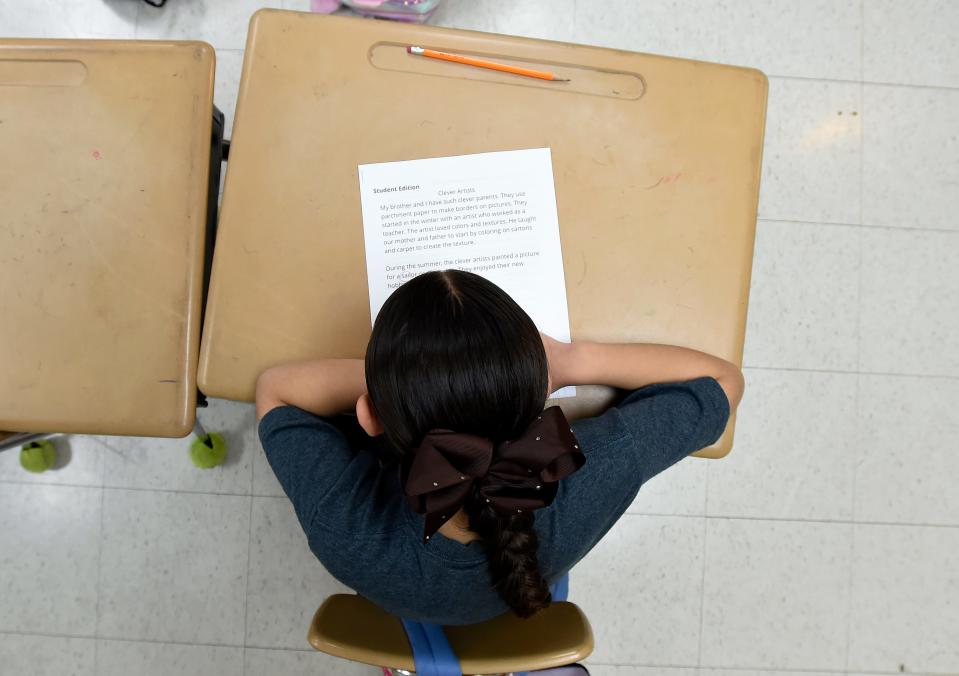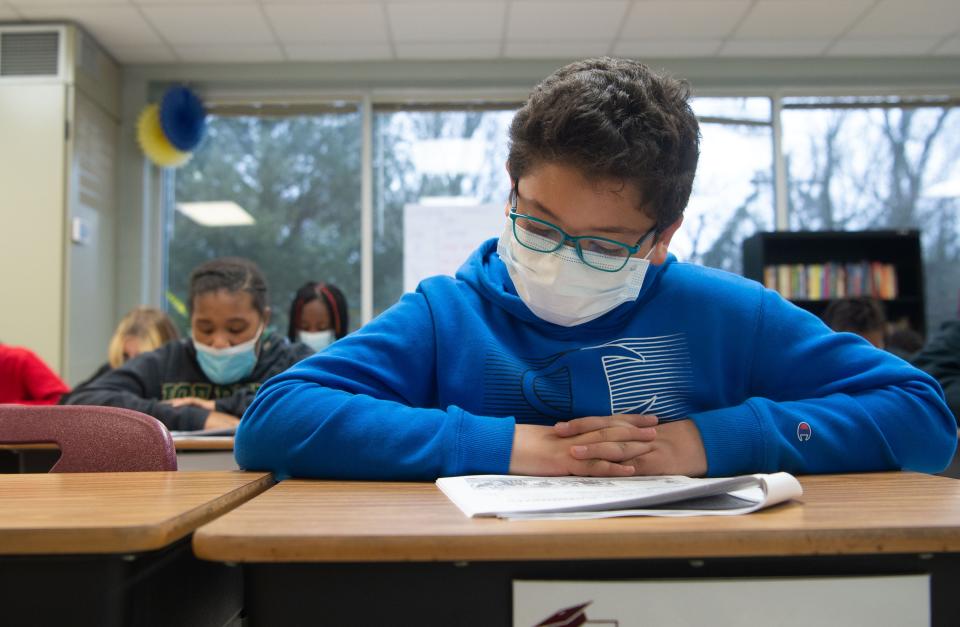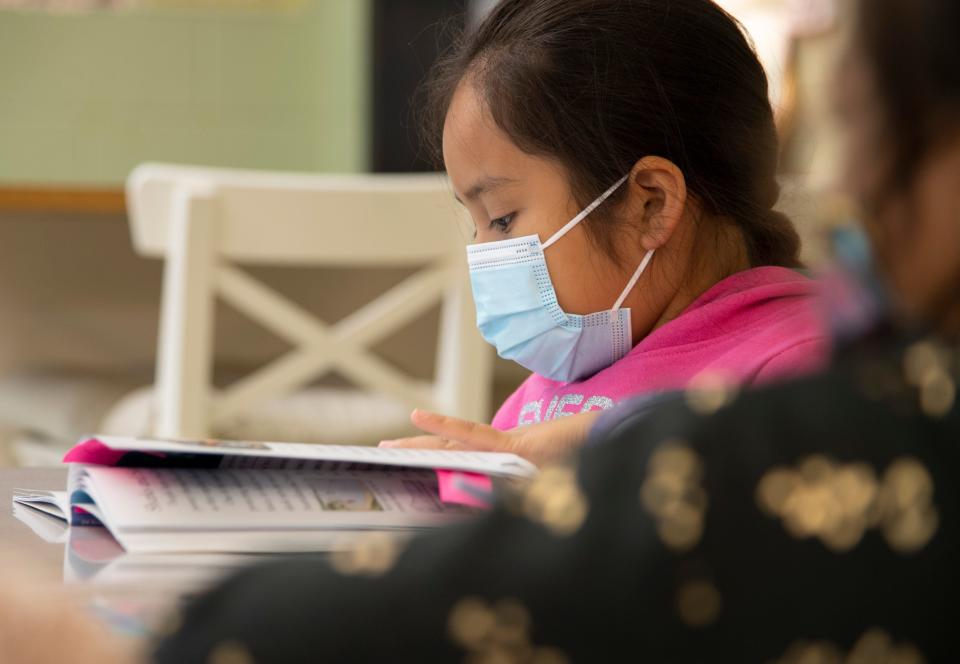Tennessee overhauled how it taught reading. There are signs it's working
Pat Bashir's excitement was contagious as she led a story hour at the downtown Nashville Public Library on a late July morning. Within a few minutes, around 40 kids and adults were on their feet dancing, stomping, clapping, waving their arms and laughing as they sang.
"¡Hola, hola, hola! ¿Cómo estás?"
The CuentaCuentos story hour, a monthly event, is entirely in Spanish. It uses a five-pronged approach to build early literacy and Spanish vocabulary through talking, singing, reading, writing and playing. By the end, even the littlest English-speaking kids were confidently speaking and singing Spanish words.

The story hour is part of a myriad of literacy efforts that Bashir leads as the children's services manager for the library system. This summer, she and her team also brought their energy as storytellers and teachers to Shwab Elementary during Promising Scholars, the summer school program offered by Metro Nashville Public Schools.
The library's efforts and summer school are just two pieces of an ongoing, massive push to boost literacy across Tennessee.
Literacy came into sharp focus as reading proficiency rates plummeted and learning loss skyrocketed for children during the coronavirus pandemic in Tennessee and nationwide. It is also at the forefront of the state's third grade reading and retention law, which took effect this year.
The state rolled out sweeping changes in its 2021 Tennessee Literacy Success Act and launched a comprehensive program known as Reading 360. It marked a shift back to phonics-based instruction, which is widely praised by experts and educators and stems from a body of research known as the science of reading.
Starting in 2021, the state mandated the following for all public schools, among other measures:
State-approved reading screeners for grades K-3, to be administered three times per school year
A two-part foundational literacy training for all licensed educators from grades K-5, to be completed by Aug. 1, 2023
Reading 360 also provides optional grants to support phonics-based instruction and support for districts, teachers and families.
So two years in, how well is Tennessee's literacy overhaul working? Here's a look at where things started, where they stand and how education leaders are measuring progress.

Phonics vs. balanced literacy
A shift back to phonics-based instruction has swept the United States in recent years, especially amid pandemic fallout and flagging reading rates. The method, also called a "sounds first" approach, starts with teaching children the basic sounds of spoken language and the letters associated with them. It then builds into decoding the meaning of words and reading fluently and coherently, with the end goal of reading comprehension, learning and the ability to write.
But for decades before, a method called balanced literacy was the go-to for reading instruction in the U.S. While it includes some phonics, the method focused on exposing kids to rich literature in an effort to make them love reading at an early age. It also used a “cueing system” that taught students to use pictures, surrounding words and sentences and other context clues to figure out what a word was.
Literacy push in Ohio: What to know about balanced literacy vs. the science of reading
Despite the fact that balanced literacy was previously debunked by scientists and researchers, the method took hold across much of the K-12 education system in the United States.
Before the changes implemented in 2021, Tennessee was following a plan known as Read to Be Ready. It emphasized a high volume of reading alongside reading and listening to complex texts on or beyond grade level. It also focused on teaching students to think deeply about the text, develop writing skills and put what they learn into practice.
"It is more than just sounding out words," then-Education Commissioner Candice McQueen said in 2016.
The program launched in spring 2018 and set a lofty goal to see 75% of Tennessee third graders reading on grade level by 2025. The state primarily uses the English language arts section of the standardized Tennessee Comprehensive Assessment Program, also known as TNReady, to measure overall literacy rates. Its standards are among the toughest in the nation.
However, English language arts scores for third graders and all grade levels stayed largely the same in 2019 before the pandemic disrupted learning. The TCAP was not given in 2020. After a decline in 2021, the scores steadily rose before surpassing pre-pandemic rates. This year, roughly 40% of third graders scored proficient in English language arts, compared to 36% in 2019. Across all grades, 38.1% scored proficient, versus 34.7% in 2019.

Tim Odegard, a professor at Middle Tennessee State University with an expertise in reading and dyslexia, said Tennessee's approach to literacy has been shaped by a tangled mess of plans spanning both political parties and several governors and U.S. presidents.
“Leaders and teachers have been subjected to back-and-forth changes and policy focus and initiatives that have left them stir crazy and dizzy, and not knowing which way is up anymore," Odegard said.
However, he said that also served as motivation for leaders, educators and families alike to figure out a path forward after the pandemic. Desperate to catch up, states across the country began to revamp reading curriculum and weed out balanced literacy, replacing it largely with phonics-based instruction.
Tennessee was one of them.
Tennessee education leaders point to growth
The general consensus among Tennessee's top education leaders is that the effort to boost literacy is working, but there's still a long way to go.
From 2017-2019, TCAP English language arts proficiency rates across all grades hovered between roughly 33-35%. In 2021, proficiency dipped to 29.7% before rebounding to 36.4% in 2022 and jumping to 38% this year.
It's important to note that, from 2017 until now, around 20% of students have consistently scored as "below expectations" on the same portion of the test, while 40-50% scored as "approaching expectations." Students are considered proficient if they score as "met" or "exceeded" expectations. Also notable: Tennessee saw 9% of students score in the "exceeded" category for English language arts, far outpacing the previous five years.
“These results reflect the dedication and continuous efforts of Tennessee districts and educators to prepare students and make academic gains,” newly appointed Tennessee Education Commissioner Lizzette Reynolds said in a news release in July. “Using this data to make informed decisions and strategic investments in education, Tennessee is well prepared for the work that lies ahead, and we will continue to put kids first.”
While statewide TCAP scores have showed gains across all subjects tested, traditionally marginalized student groups continue to lag behind their peers. Over the last seven years, Asian students have consistently exceeded their peers in science, math, social studies and English language arts. Students who are white, American Indian, Alaska natives, Native Hawaiians or other Pacific Islanders have stayed toward the middle of the pack.
Meanwhile, Black and Hispanic students remain far below their peers across all subjects, but have also made gains since the dip in scores driven by the pandemic in 2021. Students who are economically disadvantaged, English learners or have disabilities also remain well below their peers in all subjects, but have slowly built progress since 2021.
Beyond TCAP scores, leaders from the Tennessee Department of Education pointed to other parts of its literacy overhaul to illustrate progress.
While Tennessee has seen overall growth through the three reading screeners given to children in grades K-3 each year, education department leaders stopped short of providing concrete numbers. Instead, they explained how resources through Reading 360 and the Tennessee Literacy Success Act have been engaged.

Since 2021, more than 50,000 Tennessee educators representing 147 of the state's 148 districts have participated in some part of the state's suite of Reading 360 resources. The department has also gotten an influx of positive feedback from educators who underwent the new, two-part literacy training.
As of July, more than 40,000 educators completed Course I of the early reading training, and 16,878 went on to complete Course II.
Department leaders also lauded the rollout of workbooks called "decodables" designed for K-2 students. The seven-part series includes booklets with stories full of sounds and words that kids can practice at home to help them sound out words and practice reading. More than 115,000 families received the readers.
MNPS makes slow but steady gains after literacy revamp
Metro Nashville Public Schools, the state's second-largest school district, has seen an upward trend in its TCAP English language arts proficiency scores in the last two years. The scores returned to pre-pandemic levels, while also posting gains in the percentage of students who scored as exceeding expectations.
Here's a quick snapshot of the district's English language arts proficiency scores:
2017: 25.6% proficient / 74.4% not proficient
2018: 25.3% proficient / 74.7% not proficient
2019: 25.9% proficient / 74.1% not proficient
2021: 19.7% proficient / 80.3% not proficient
2022: 26.9% proficient / 73.1% not proficient
2023: 28.5% proficient / 71.5% not proficient
While important, TCAP scores serve as an overview for the district and its individual schools, according to Chief Academic Officer Mason Bellamy.
MNPS launched an initiative called Literacy ReimaginED in the 2021-22 school year, which adopted intensive professional development for teachers and high-quality, uniform literacy curriculum for grades K-12. The initiative joined a new tutoring program to help students catch up across all subjects and other existing resources, like summer school. It also folded in some of the state's Reading 360 resources and training requirements.
MNPS offers a multi-tiered system of support, with tier one representing the basic education all students receive. Each tier beyond that offers more supports based on a student’s individual needs, including tutoring and other interventions.
Bellamy said the literacy initiative is first about improving tier one, with the goal of boosting outcomes for every single student.
“Regardless of what school your child goes to, regardless of what classroom they're in, they will be taught in rigorous ways, they will be taught by well-prepared teachers, and they will be taught using the same curriculum, the same methods and the same strategies,” Bellamy said. “Our data shows that it’s paying off.”

So how is MNPS measuring literacy progress? It’s more complicated than a single number, like a TCAP score, according to Bellamy.
He gave an example to explain: 27% of last year’s MNPS third graders scored as proficient on the TCAP English language arts section. This year, that number was 31%. However, those numbers measure two different groups of students, and therefore aren't directly comparable.
Instead, MNPS measures progress based on growth goals for every student each year. In grades K-3, those goals are informed in part by the universal reading screeners. A growth goal could be a child moving from below proficiency to approaching proficiency, or boosting a reading score from one percentile to another. Bellamy also said reading screeners are used as a diagnostic tool to identify where students need the most help.
The district set a goal for 50% of all students to be at or above their literacy growth goals in the 2022-23 school year. Bellamy said they exceeded that, with 57-63% of students hitting those goals, depending on grade level.
While Bellamy, who started his role in November 2019, is proud of the district's recent progress, he knows the fight is far from over. He looks forward to building upon its literacy initiative — and to the day when MNPS surpasses the state’s average literacy rate.
“We're going to continue to double down and invest in the things that we've seen, two years running, are working,” he said.
Expert: Building literacy in Tennessee requires a long-haul effort
Odegard, the MTSU professor, works closely with educators and leaders across Tennessee as he divides his time between research, outreach and teaching. When it comes to children's literacy, he's witnessed great eagerness to correct the course. That desire paired with the new literacy laws, mandated trainings, funding and resources has built momentum.
While the last few years have shown promising growth, it will take years of consistent effort to really see the fruit of this effort, Odegard said. He pointed to the dramatic turnaround in literacy rates Mississippi made in recent years. Some hailed it as the "Mississippi miracle."
"That was a decade in the making," Odegard said. "The miracle, it was a whole lot of hard work."
But by and large, Odegard believes deeply in the ability and dedication of Tennessee's educators to measure up to the new law, with the ultimate goal of helping students succeed.
“They're wanting to be compliant first, but they also want to do right by those kids," Odegard said. "That can't be stated enough. They're gaining awareness that what they used to do, in many instances, wasn't what they needed to do. They never wanted to harm those kids."
Learn more
More information on Tennessee's Reading 360 program can be found at tn.gov/education/reading-360.
State and district TCAP data, including an in-depth look at scores, demographics and more, can be found at reportcard.tnedu.gov. The state's information hub on K-12 education and resources can be found at bestforall.tnedu.gov.
National academic performance statistics, reports, data dashboards and more can be found at nationsreportcard.gov.
Information on curriculum and instruction for Metro Nashville Public Schools can be found at mnps.org/learn/academics/curriculum-and-instruction.
This article originally appeared on Nashville Tennessean: Tennessee schools: This shift in reading leads to gains after pandemic

